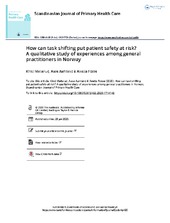| dc.contributor.author | Malterud, Kirsti | en_US |
| dc.contributor.author | Aamland, Aase | en_US |
| dc.contributor.author | Fosse, Anette | en_US |
| dc.date.accessioned | 2020-07-02T11:57:37Z | |
| dc.date.available | 2020-07-02T11:57:37Z | |
| dc.date.issued | 2020 | |
| dc.Published | Malterud K, Aamland AA, Fosse A. How can task shifting put patient safety at risk? A qualitative study of experiences among general practitioners in Norway. Scandinavian Journal of Primary Health Care. 2020;38(1):24-32 | eng |
| dc.identifier.issn | 1502-7724 | |
| dc.identifier.issn | 0281-3432 | |
| dc.identifier.uri | https://hdl.handle.net/1956/23255 | |
| dc.description.abstract | Objective: To describe experiences among general practitioners (GPs) in Norway regarding horizontal task shifting experiences associated with adverse events that potentially put patient safety at risk. Design and contributors: We conducted a qualitative study with data from a retrospective convenience sample of consecutive, already posted comments in a restricted Facebook group for GPs in Norway. The sample consisted of 43 unique posts from 38 contributors (23 women and 15 men), presenting thick and specific accounts of potentially adverse events in the context of horizontal task shifting. Analysis was conducted with systematic text condensation, a method for thematic cross-case analysis. Results: Contributing GPs reported several types of adverse events associated with horizontal task shifting that could put patient safety at risk. They described how spill-over work dispatched to GPs may generate administrative hassle and hazardous delay of necessary examinations. Overdiagnosis, reduced access and endangered accountability occur when time-consuming procedures and pre-investigation before referral are pushed upon GPs. Resource-draining chores beyond GPs’ proficiency is also dispatched without appropriate instruction or equipment. Furthermore, potential malpractice is imposed by hospital colleagues who overrule the GPs’ medical judgement. Implications: Patient safety is endangered when horizontal task shifting is initiated and performed without a systematic process involving all stakeholders that considers available resources. A risk and vulnerability analysis, securing competent staff, resources, time and equipment before launching such reforms is necessary to protect patient safety. Infrastructure comprised of local coordination groups may facilitate dialogue between health care service levels and negotiate responsibilities and workload. | en_US |
| dc.language.iso | eng | eng |
| dc.publisher | Taylor & Francis | eng |
| dc.rights | Attribution CC BY | eng |
| dc.rights.uri | http://creativecommons.org/licenses/by/4.0 | eng |
| dc.title | How can task shifting put patient safety at risk? A qualitative study of experiences among general practitioners in Norway | en_US |
| dc.type | Peer reviewed | |
| dc.type | Journal article | |
| dc.date.updated | 2020-01-23T10:17:21Z | |
| dc.description.version | publishedVersion | en_US |
| dc.rights.holder | Copyright 2020 The Author(s) | |
| dc.identifier.doi | https://doi.org/10.1080/02813432.2020.1714143 | |
| dc.identifier.cristin | 1780698 | |
| dc.source.journal | Scandinavian Journal of Primary Health Care | |

